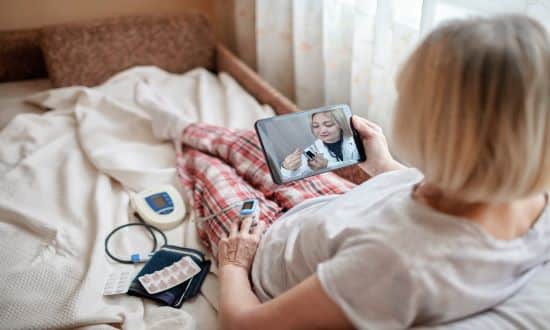NHS England guidance asks ICSs to extend or introduce virtual wards
- 9 May 2022

Latest guidance has revealed that NHS England and NHS Improvement is asking all Integrated Care Systems (ICSs) to extend or introduce the virtual ward model.
The document, titled ‘Supporting information for ICS leads: Enablers for success: virtual wards including hospital at home’, aims to support ICSs with their strategic and financial decisions on virtual ward planning and implementation.
The content is positioned at ICS leadership teams but it is also helpful for provider organisations as well. The guidance includes a two-year transformation programme to support the development of virtual wards operating to standardised clinical models, across every area of England.
The report, which was published in April 2022, begins with a focus on ambition, explaining that ICSs have been asked to deliver virtual ward capacity equivalent to 40 to 50 virtual ward ‘beds’ per 100,000 population (equal to the delivery of up to 24,000 virtual ward beds), by December 2023.
At a minimum, NHS England state that they expect each system to implement virtual ward models for the two pathways (acute respiratory infection and frailty) defined in previous guidance first published in December 2021.
Depending on the starting point and maturity of services, systems may wish to expand and develop other pathways in addition, the report outlines.
NHS England also stress that virtual ward services should be developed across systems and provider collaboratives rather than individual institutions and should be tech-enabled to maximise the opportunity they offer for patients, carers and staff.
Virtual ward services will only be successful if they combine all of the above in creating an integrated care model, the guidance states and hence the first test of ICSs will be to deliver a new multi-agency approach to supporting people to be cared for in their own homes or usual place of residence.
The publication includes various sections to support ICSs, such as available funding and recommended use, system-level reporting and data requirements, monitoring and assurance, workforce recommendations, technology enablement, developing data flows for reporting and evaluation, working with the independent sector, equality and health inequalities, and green considerations.
Chris Hopson, chief executive at NHS Providers, said: “We welcome guidance to support Integrated Care Systems to expand the virtual wards model, in line with wider ambitions for the NHS to move more care within and closer to home.
“Virtual wards allow patients who otherwise would be in hospital to receive acute care, monitoring and treatment at home. This can have benefits for individual patients and their outcomes, as well as for the flow of patients through the wider health and care system by helping to prevent avoidable admissions and support safe and timely discharges.
“Virtual wards represent a significant change to the way that the NHS delivers care in the community and will require joined up working across the health and care system. Given the scale of the challenge, access to sufficient funding and support will be essential to ensure that the benefits of virtual wards are delivered for patients.”
In terms of funding, the document reveals that £200million is available from the Service Development Fund (SDF) in 2022/23, which will contribute significantly to the set up and development of virtual wards.
A further contribution of £250million, on a match-funded basis, will be available in 2023/24, however no ringfenced recurrent funding will be made available from 2024/25, meaning systems will need to ensure virtual wards are built into long term strategies and expenditure plans.
NHS England have also provided ICSs with good practice recommendations for virtual ward workforce models.
These include having an appropriate clinical leadership and governance in place, a competency-based approach that avoids assumptions about professional boundaries and early investment in workforce development training, integrated working across health and social care, appropriate use of technology with training and supervision, and an incremental approach to improvement and growth.
Virtual wards have begun to emerge around the country, particularly in Leicester where the University Hospitals of Leicester NHS Trust opened a second virtual Covid ward in February 2021 and became one of the first trusts in the UK to create a virtual ward for patients with atrial fibrillation in March of this year.





3 Comments
I see difficulties ahead with virtual wards, whichare mostly cultural not organisational:
1. How do you get GPs and hospitals to accept the strange hybrid new way of working.?
2. Who will staff the virtual wards?
3. How do you choose suitable patients?
4. How do you clobber the nay-sayers?
I wish the project well, but am not sure the instigators realise how revolutionary the project is, and how difficult to implement.
I was going to ask what on earth a virtual ward is, when I realised I had just been a patient in one. In my case it was called ‘hospital at home.”
For two weeks, I was visited nearly every day by a doctor and/or nurse, who took my blood pressure, did a blood test, weighed me and sounded my chest. They then juggled with my medication.
It was great. have never felt so pampered by the NHS.
I was puzzled by the whole exercise. Why had I been selected for this treat. Who had authorized it?
Later, I discoverd that a visit to my local hospital to have my pacemaker checked had resulted in in one of the clinicians diagnosing heart-failure.
The service was not provided by the hospital ut b Community Services. After two weeks, they went away, without leaving a Discharge Summary, so I was left in the dark about what they had achieved. Initially my GP was not aware of their visit. This seemed to me just another example of NHS failure to communicate: a pity with an important initiative like this.
Since then, my kidney function has dropped off a cliff. I wonder if I will go into another ‘virtual ward’. I do hope so.
Money for old rope.
We are just submitting data about patients who were already at home, and now we say they are in a virtual ward and everyone is quids in.
Happy days.
Comments are closed.